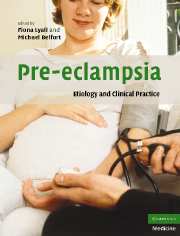Book contents
- Frontmatter
- Contents
- List of contributors
- Preface
- Part I Basic science
- 1 Trophoblast invasion in pre-eclampsia and other pregnancy disorders
- 2 Development of the utero-placental circulation: purported mechanisms for cytotrophoblast invasion in normal pregnancy and pre-eclampsia
- 3 In vitro models for studying pre-eclampsia
- 4 Endothelial factors
- 5 The renin–angiotensin system in pre-eclampsia
- 6 Immunological factors and placentation: implications for pre-eclampsia
- 7 Immunological factors and placentation: implications for pre-eclampsia
- 8 The role of oxidative stress in pre-eclampsia
- 9 Placental hypoxia, hyperoxia and ischemia–reperfusion injury in pre-eclampsia
- 10 Tenney–Parker changes and apoptotic versus necrotic shedding of trophoblast in normal pregnancy and pre-eclampsia
- 11 Dyslipidemia and pre-eclampsia
- 12 Pre-eclampsia a two-stage disorder: what is the linkage? Are there directed fetal/placental signals?
- 13 High altitude and pre-eclampsia
- 14 The use of mouse models to explore fetal–maternal interactions underlying pre-eclampsia
- 15 Prediction of pre-eclampsia
- 16 Long-term implications of pre-eclampsia for maternal health
- Part II Clinical Practice
- Subject index
- References
9 - Placental hypoxia, hyperoxia and ischemia–reperfusion injury in pre-eclampsia
from Part I - Basic science
Published online by Cambridge University Press: 03 September 2009
- Frontmatter
- Contents
- List of contributors
- Preface
- Part I Basic science
- 1 Trophoblast invasion in pre-eclampsia and other pregnancy disorders
- 2 Development of the utero-placental circulation: purported mechanisms for cytotrophoblast invasion in normal pregnancy and pre-eclampsia
- 3 In vitro models for studying pre-eclampsia
- 4 Endothelial factors
- 5 The renin–angiotensin system in pre-eclampsia
- 6 Immunological factors and placentation: implications for pre-eclampsia
- 7 Immunological factors and placentation: implications for pre-eclampsia
- 8 The role of oxidative stress in pre-eclampsia
- 9 Placental hypoxia, hyperoxia and ischemia–reperfusion injury in pre-eclampsia
- 10 Tenney–Parker changes and apoptotic versus necrotic shedding of trophoblast in normal pregnancy and pre-eclampsia
- 11 Dyslipidemia and pre-eclampsia
- 12 Pre-eclampsia a two-stage disorder: what is the linkage? Are there directed fetal/placental signals?
- 13 High altitude and pre-eclampsia
- 14 The use of mouse models to explore fetal–maternal interactions underlying pre-eclampsia
- 15 Prediction of pre-eclampsia
- 16 Long-term implications of pre-eclampsia for maternal health
- Part II Clinical Practice
- Subject index
- References
Summary
Introduction
Oxidative stress of the placenta is a key element in the pathogenesis of pre-eclampsia, although its precise contribution remains uncertain (Hubel, 1999; Redman and Sargent, 2000). The aim of this chapter is to address the origin of that oxidative stress and, as the title suggests, to consider the effects of different oxygen concentrations on placental tissues. In the past it has widely been assumed that the vascular abnormalities in the endometrial arteries of women with pre-eclampsia result in reduced placental perfusion, and hence chronic hypoxia within the feto-placental unit. More recently, the converse has been proposed, and that in pre-eclampsia associated with intrauterine growth restriction (IUGR) the placenta is in fact hyperoxic due to less oxygen than normal being extracted from the intervillous space by the smaller fetus (Kingdom and Kaufmann, 1997). Hypoxia and hyperoxia are relative terms, however, and these assessments have of necessity been based on data obtained at the time of delivery, which, in the majority of cases, represents the end-stage of a process that may have been developing over many weeks. It is therefore difficult to separate primary from secondary effects, and to elucidate earlier stages in the pathogenesis of the disorder. The situation is further complicated by the fact that pre-eclampsia varies widely in severity. Late onset pre-eclampsia is often associated with normal birthweight, whereas early onset of the disease is generally linked with IUGR (Douglas and Redman, 1994).
- Type
- Chapter
- Information
- Pre-eclampsiaEtiology and Clinical Practice, pp. 138 - 151Publisher: Cambridge University PressPrint publication year: 2007
References
- 1
- Cited by



